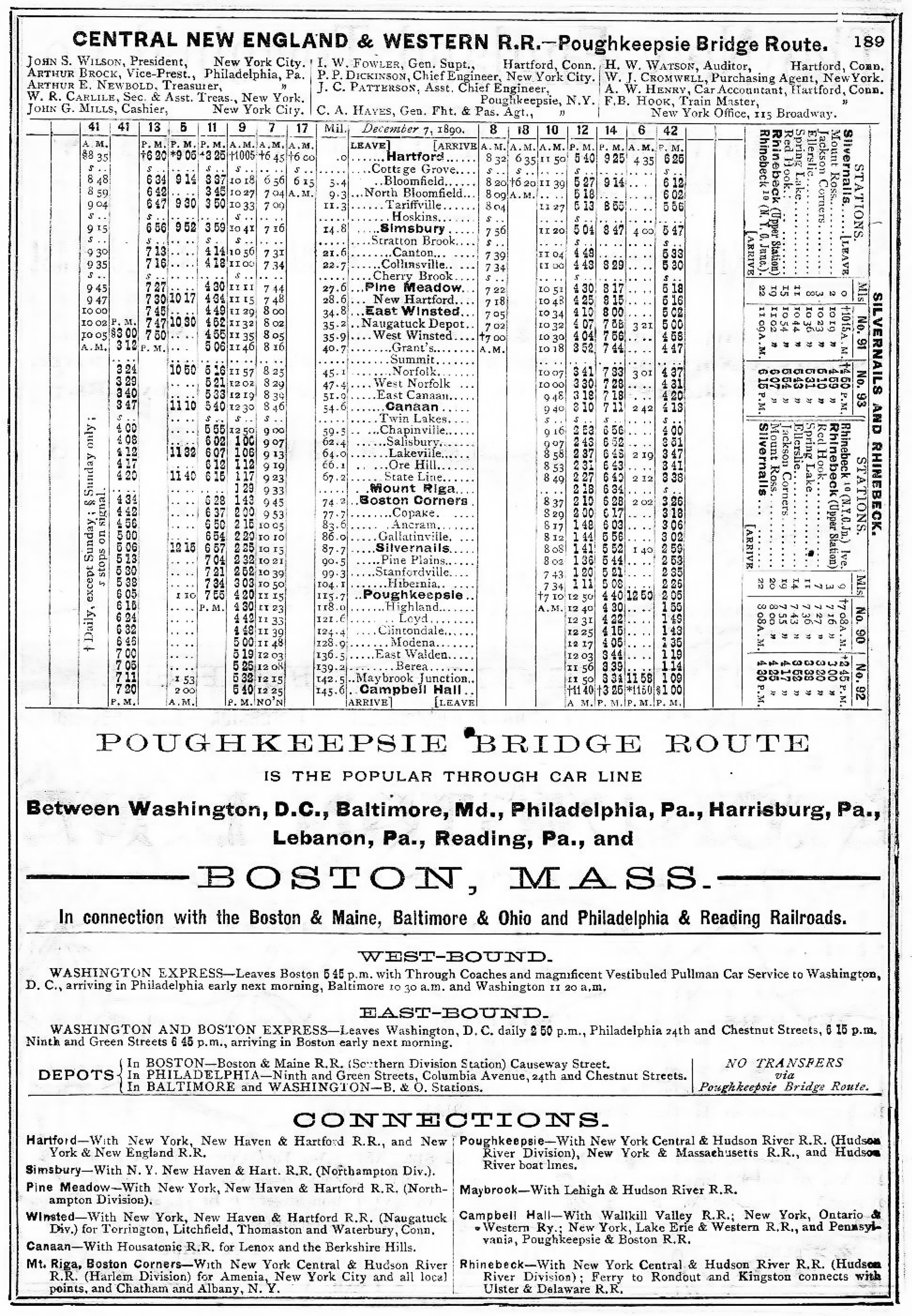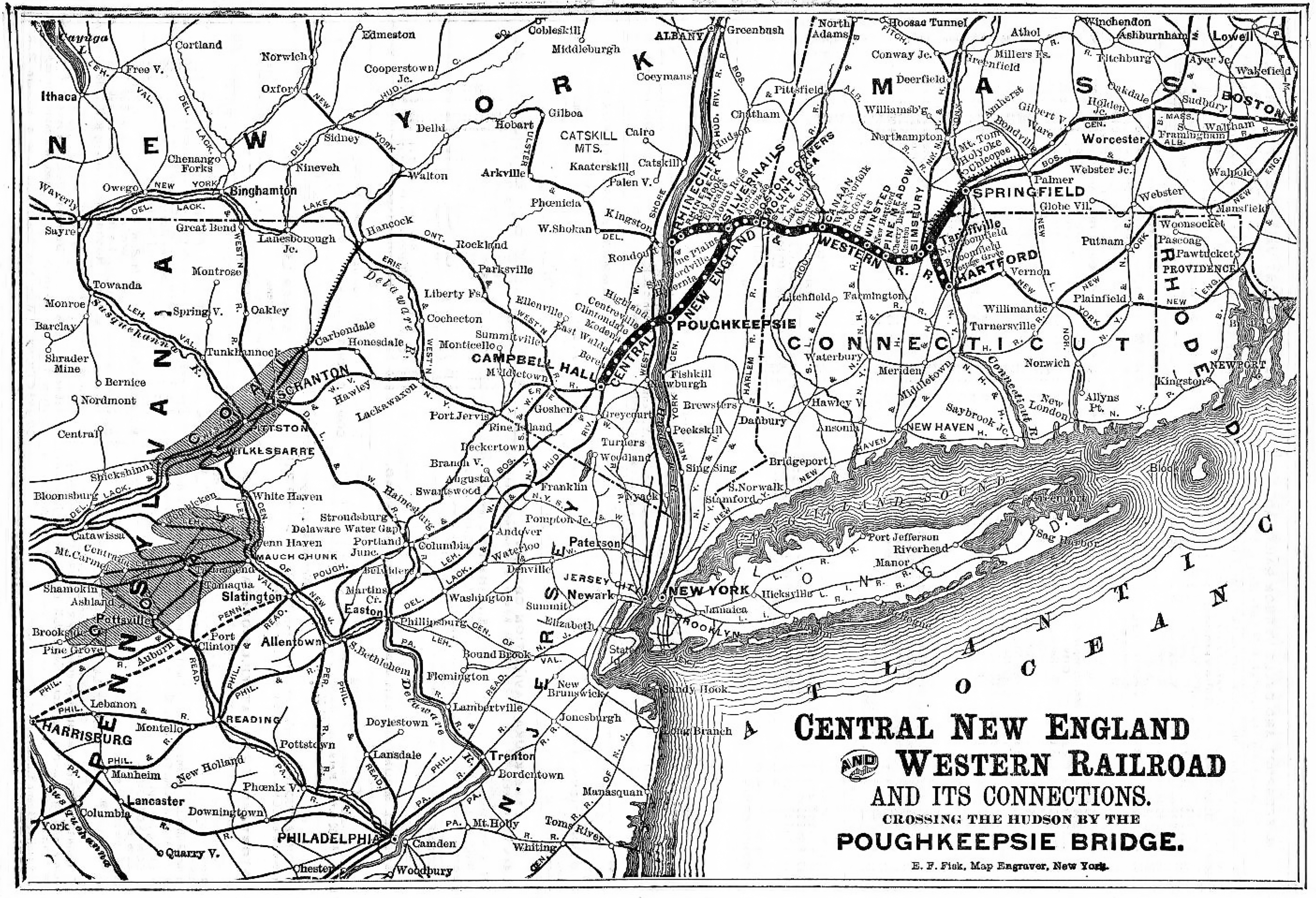Central New England Railway: "The Poughkeepsie Bridge Route"
Published: February 16, 2025
By: Adam Burns
The Central New England Railway (CNE) played a significant role in the transportation history of the northeastern United States, acting as a vital link to western outlets for the region's smaller railroads.
From its inception in the 19th century to its absorption into the New Haven, the CNE's story is one of ambition, innovation, and adaptation to changing economic and technological landscapes.
The CNE's network extended from Hartford, Connecticut, and Springfield, Massachusetts, westward across northern Connecticut, traversing the Hudson River via the Poughkeepsie Bridge, and reaching Maybrook, New York.
The railroad was integral as the Poughkeepsie Bridge Route, where the line became an important component of the later Alphabet Route - a consortium of railroads offering shippers an alternative to the three major eastern trunk lines between New York/Boston and Chicago/St. Louis.
In 1904, the New York, New Haven & Hartford Railroad acquired the CNE and initially operated it as an independent entity before fully integrating it in 1927. By the 1930s and 1940s, the majority of the CNE network was abandoned, and even the Poughkeepsie Bridge discontinued use in the 1970s. Today, remaining segments of the former railroad are managed by shortlines Central New England Railroad and the Housatonic Railroad.
System Map (1891)
Origins and Early Development
The roots of the Central New England Railway can be traced back to various small, independent railroads beginning with the Connecticut Western Railroad of 1868. These early systems were typical of the era, with regional entrepreneurs seeking to leverage the growing demand for efficient transportation routes.
Main Line
The CNE's heritage begins with the Connecticut Western Railroad, officially chartered on June 25, 1868 to connect Hartford, Connecticut with the New York state boundary. At this juncture, it was intended to connect with the Dutchess & Columbia Railroad just east of Millerton, New York.
Following three years of construction the line opened on December 21, 1871. In the preceding month, the company strategically leased the easternmost segment of the D&C to secure access to the New York & Harlem Railroad in Millerton.
Notably, the railroad's only branch was a modest extension into Collinsville, Connecticut, which was not finalized until December 1874. The Connecticut Western fell into bankruptcy on April 27, 1880, and subsequently underwent reorganization on March 31, 1881, emerging as the Hartford & Connecticut Western Railroad.
Meanwhile, the Rhinebeck & Connecticut Railroad was established in New York on June 29, 1870. Its promoters were attempting to construct a line from Rhinecliff on the Hudson River eastward to the Connecticut state line, thereby connecting with the Connecticut Western.
Following five years of work the road opened on April 14, 1875, extending from Rhinecliff eastward to Boston Corners, New York. From Boston Corners to the state line, the R&C negotiated trackage rights over the Poughkeepsie & Eastern Railroad, which intersected with the Connecticut Western and Dutchess and Columbia at the state border.
On July 1, 1882, the Hartford & Connecticut Western acquired the Rhinebeck & Connecticut Railroad, thereby establishing a continuous route from Hartford to the Hudson River.
The Poughkeepsie, Hartford & Boston Railroad, the entity succeeding the Poughkeepsie & Eastern, succumbed to bankruptcy in the 1880s. Consequently, on January 26, 1884, the H&CW purchased outright the section of track east of Boston Corners that it had previously operated under trackage rights.
Building The Poughkeepsie Bridge
Over the years, numerous proposals were developed to establish a permanent crossing over the Hudson River south of Albany, replacing the various car float operations. Among the most persistent efforts was the Hudson Highland Suspension Bridge Company, initially chartered in 1868, which proposed a crossing from Anthony's Nose to Fort Clinton, near the current location of the Bear Mountain Bridge.
Ultimately, the proposal that materialized was the Poughkeepsie Bridge at Poughkeepsie. The Poughkeepsie Bridge Company was established in June 1871 to construct this massive span, and the first train passed over the structure on December 29, 1888.
In 1887, the Hudson Connecting Railroad was chartered to extend southwest from the bridge, while concurrently, the Poughkeepsie & Connecticut Railroad was chartered to extend the line northeast from Poughkeepsie. Although the bridge company aimed to acquire the Poughkeepsie, Hartford & Boston Railroad, this attempt failed, leading to the chartering of the P&C to parallel the route, culminating at the Hartford & Connecticut Western Railroad in Silvernails, New York.
The connections were completed in 1889, and on July 22, the two extensions merged, forming the Central New England & Western Railroad. In the same year, the CNE&W leased the Hartford & Connecticut Western, securing a route from Hartford across the Hudson River to Maybrook and Campbell Hall, New York, which quickly became a crucial junction for various railroads transferring cars to the CNE&W.
Formation
Furthermore, in 1889, the Delaware & New England Railroad was established as a holding company owning both the CNE&W and Poughkeepsie Bridge Company. The Central New England Railway emerged through a series of mergers and organizational restructurings.
In April 1890, the CNE&W chartered the Dutchess County Railroad to extend southeast from the east end of the Poughkeepsie Bridge to Hopewell Junction, linking with the New York & New England Railroad (NY&NE) and the Newburgh, Dutchess & Connecticut Railroad. This line commenced operations on May 8, 1892.
The Philadelphia & Reading acquired both the CNE&W and Poughkeepsie Bridge Company from D&NE in January 1892, broadening the anthracite coal road's reach into New England through subsidiary Pennsylvania, Poughkeepsie & Boston Railroad.
On August 1, 1892, these entities merged to form the Philadelphia, Reading & New England Railroad (PR&NE). However, the financial Panic of 1893 brought down Archibald McLeod's empire, which included the Reading system.
The PR&NE defaulted on its interest obligations in May 1893 and it was reorganized as the Central New England Railway (CNE) on January 12, 1899.
Timetables (1891)

Strategic Importance and Operations
The Central New England's strategic importance lay in the Poughkeepsie Bridge and the ability of this strategic span to connect New England's smaller railroads - notably the Boston & Maine, Maine Central, New Haven, and Bangor & Aroostook - with the Reading, Jersey Central, Lehigh & Hudson River, Nickel Plate Road, Wheeling & Lake Erie, and Pittsburgh & West Virginia in providing an alternative routing to New York and Midwestern markets.
This made it a valuable asset for businesses and industries in the region looking for efficient transport solutions outside of the B&O, PRR, NYC, and even the Erie. In this way, the CNE played a pivotal role in the agricultural and industrial supply chains of the late 19th and early 20th centuries.
Farmers and manufacturers relied heavily on the railroad to transport products like dairy, tobacco, and textiles to market. Meanwhile, industries received raw materials, such as coal and iron, via the CNE, feeding the industrial growth of the northeastern United States.
New Haven Operations
On January 1, 1927, the Central New England was integrated into the New Haven network. Subsequently, the NYNH&H discontinued most passenger operations on the CNE, except for the section extending from Copake, New York, through Stanfordville and Pleasant Valley to Poughkeepsie, which remained operational until at least January 1932.
Despite its strategic position, the CNE faced significant challenges, particularly concerning competition and financial sustainability. It was also notorious for having the steepest grades among the various east-west New Haven routes; consequently, most bridge traffic was redirected through the former NY&NE to Hopewell Junction.
Cutbacks and Abandonments
In 1932, the segment of the former Rhinebeck & Connecticut from Copake (northwest of Boston Corners) to the state border was abandoned, effectively severing the CNE. In 1937, the New Haven dismantled the Waterbury-Southbury segment, disrupting a crucial route in the east-west rail corridor between the mid-Hudson Valley (Campbell Hall and Poughkeepsie) and eastern Connecticut (Willimantic).
Further closures followed in 1938, when the main line was shut down from East Canaan east to Tariffville, including the entirety of the Springfield Branch. Additional sections were abandoned northeast and east from Poughkeepsie and Rhinecliff, including the Poughkeepsie & Eastern (P&E) and the main line eastward from the state boundary to Lakeville.
Between East Canaan and Canaan, the main line was closed in 1940, and the segment between Lakeville and Canaan was abandoned in 1965.
By the time of New Haven's January 1, 1969 merger into Penn Central, the only remnants of the original CNE remaining were the westernmost segment from Maybrook across the Poughkeepsie Bridge, southeast along the Dutchess County Railroad to the former NY&NE, and the easternmost section extending to the northern part of Bloomfield, Connecticut, from Hartford.
This western segment was a part of the Maybrook Branch, continuing east over former NY&NE lines to Derby. Following the closure of the Poughkeepsie Bridge on May 8, 1974, the Maybrook Branch was abandoned west of Hopewell Junction. By 1976, the residual line was integrated into Conrail.
Subsequently, the Connecticut Department of Transportation acquired this portion, and in January 1999, short line Central New England Railroad commenced operations along the 8.7-mile Griffins Industrial Track. The Housatonic Railroad currently operates a minor segment of the original CNE line in Canaan to facilitate a limestone quarry situated east of its mainline alongside the preserved Canaan Union Depot.
Legacy
Although the CNE is long gone, its legacy endured through the infrastructure and economic contributions it made. The railroad played a foundational role in shaping the transportation routes and economic networks within New England.
The emphasis on creating an alternative transportation option and fostering regional development left a lasting imprint on the infrastructure strategies of subsequent railroad enterprises and policymakers.
The story of the CNE also provides valuable insights into the dynamics of early railroad development in the United States, illustrating the impact of competition, consolidation, and technology changes on small and mid-sized railroads.
Its history is reflective of broader trends that defined the golden era of American railroading, including the shift toward larger railroad systems and the impact of emerging transportation technologies.
Recent Articles
-
Explore Alabama By Rail!
Feb 21, 25 09:00 PM
There are currently just a few train rides in Alabama to choose from. Learn more about them within this guide, as well as the state's railroad museums. -
Peoria and Eastern Railway
Feb 21, 25 04:45 PM
The Peoria and Eastern Railway was a notable subsidiary of the New York Central with a heritage tracing back to the 1830s. Much of the system was abandoned in Illinois by the 1990s. -
Rogers Locomotive and Machine Works
Feb 21, 25 11:05 AM
The Rogers Locomotive and Machine Works was a major U.S. manufacturer throughout the 19th century, specializing in locomotives and heavy machinery. It merged with Alco in 1905.



